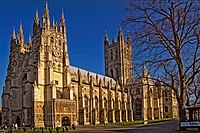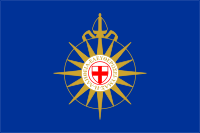Anglican Communion | |
|---|---|
 | |
| Type | Communion |
| Classification | Protestant[note 1] |
| Orientation | Anglican |
| Scripture | Protestant Bible |
| Theology | Anglican doctrine |
| Polity | Episcopal |
| Primate of All England | Archbishop of Canterbury |
| Secretary | Josiah Idowu-Fearon |
| Region | Worldwide |
| Headquarters | London, England |
| Founder | Charles Longley |
| Origin | 1867 Lambeth Conference, London, England |
| Separated from | Roman Catholic Church |
| Separations | Continuing Anglican movement (1977) Some participants in the Anglican realignment (since 2002; partial) |
| Members | 85,000,000[1] |
| Official website | anglicancommunion.org |
| Logo |  |
| Anglican Communion |
|---|
 |
| Part of a series on Anglicanism |
| Organisation |
| Theology |
| Liturgy and worship |
| Other topics |
|
|
The Anglican Communion is the third largest Christian communion after the Roman Catholic and Eastern Orthodox churches.[2][3][4] Formally founded in 1867 in London, the communion has more than 85 million members[5][6][7] within the Church of England and other autocephalous national and regional churches in full communion.[8] The traditional origins of Anglican doctrine are summarised in the Thirty-nine Articles (1571) and The Books of Homilies.[9] The archbishop of Canterbury in England acts as a focus of unity, recognised as primus inter pares ("first among equals"), but does not exercise authority in Anglican provinces outside of the Church of England. Most, but not all, member churches of the communion are the historic national or regional Anglican churches.[10][11][12][13]
The Anglican Communion was officially and formally organised and recognised as such at the Lambeth Conference in 1867 in London under the leadership of Charles Longley, Archbishop of Canterbury. The churches of the Anglican Communion consider themselves to be part of the one, holy, catholic and apostolic church, and to be both Catholic and Reformed. As in the Church of England itself, the Anglican Communion includes the broad spectrum of beliefs and liturgical practises found in the Evangelical, Central and Anglo-Catholic traditions of Anglicanism. Each national or regional church is fully independent, retaining its own legislative process and episcopal polity under the leadership of local primates. For some adherents, Anglicanism represents a non-papal Catholicism, for others a distinct form of Reformed Protestantism that emerged under the influence of Thomas Cranmer,[9] or for yet others, a combination of the two.[14]
Most of its members live in the Anglosphere of former British territories. Full participation in the sacramental life of each church is available to all communicant members. Because of their historical link to England (ecclesia anglicana means "English church"), some of the member churches are known as "Anglican", such as the Anglican Church of Canada. Others, for example the Church of Ireland and the Scottish and American Episcopal churches, have official names that do not include "Anglican". Conversely, some churches that do use the name "Anglican" are not part of the communion. These have generally disaffiliated over disagreement with the direction of the communion.
Cite error: There are <ref group=note> tags on this page, but the references will not show without a {{reflist|group=note}} template (see the help page).
- ^ "Anglicanismo". Igreja Anglicana (in Brazilian Portuguese). Archived from the original on 2 January 2020. Retrieved 2 January 2020.
- ^ Goodhew, David (2016). Growth and Decline in the Anglican Communion: 1980 to the Present. Taylor & Francis. pp. 45, 46, 47, 48, 49, 50. ISBN 978-1-317-12442-9.
- ^ Chapman, Mark David; Clarke, Sathianathan; Percy, Martyn (2016). The Oxford Handbook of Anglican Studies. Oxford University Press. pp. 1, 341. ISBN 978-0-19-921856-1.
- ^ Harvard Divinity School, Religious Literacy Project. "Anglican Communion Suspends Episcopal Church Over Same-Sex Marriage". RLP.HDS.harvard.edu. Archived from the original on 4 August 2020. Retrieved 6 May 2020.
- ^ "The Anglican Communion official website – "Provincial Registry"". Archived from the original on 7 March 2015. Retrieved 9 January 2017.
- ^ Kurian, George Thomas; Lamport, Mark A. (2015). Encyclopedia of Christian Education. Rowman & Littlefield. p. 50. ISBN 978-0-8108-8493-9.
With a membership currently estimated at over 85 million members worldwide, the Anglican Communion is the third largest Christian communion in the world, after the Roman Catholic Church and the Eastern Orthodox churches.
- ^ Muñoz, Daniel (May 2016). "North to South: A Reappraisal of Anglican Communion Membership Figures". Journal of Anglican Studies. 14: 71–95. doi:10.1017/S1740355315000212. S2CID 147105475.
- ^ "St Francis of Assisi Episcopal Church History". 20 July 2012. Archived from the original on 15 August 2012. Retrieved 11 August 2011.
- ^ a b Samuel, Chimela Meehoma (28 April 2020). Treasures of the Anglican Witness: A Collection of Essays. Partridge Publishing. ISBN 978-1-5437-5784-2.
In addition to his emphasis on Bible reading and the introduction to the Book of Common Prayer, other media through which Cranmer sought to catechize the English people were the introduction of the First Book of Homilies and the 39 Articles of Religion. Together with the Book of Common Prayer and the Forty-Two Articles (which were later reduced to thirty-nine), the Book of Homilies stands as one of the essential texts of the Edwardian Reformation, and they all helped to define the shape of Anglicanism then, and in the subsequent centuries. More so, the Articles of Religion, whose primary shape and content were given by Archbishop Cranmer and Bishop Ridley in 1553 (and whose final official form was ratified by Convocation, the Queen, and Parliament in 1571), provided a more precise interpretation of Christian doctrine to the English people. According to John H. Rodgers, they "constitute the formal statements of the accepted, common teaching put forth by the Church of England as a result of the Reformation."
- ^ "The Anglican Communion". The Church of England. Retrieved 5 August 2024.
- ^ "The Anglican Communion". The Anglican Centre in Rome. 12 May 2020. Retrieved 5 August 2024.
- ^ Chapman, Mark D. (2015). "Anglicanism, Japan, and the Perception of a Higher Civilization in the Early Twentieth Century". Anglican and Episcopal History. 84 (3): 298–320. ISSN 0896-8039. JSTOR 43685136.
- ^ "Member Churches". Anglican Communion.
- ^ Avis 1998, pp. 417–419.